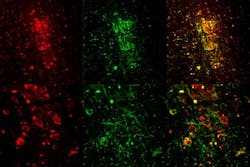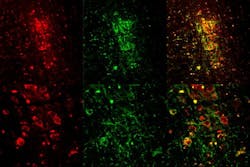Researchers use optogenetics to trigger REM sleep in mice
A team of researchers at the Massachusetts Institute of Technology (MIT; Cambridge, MA) has moved a step closer to being able to produce natural sleep patterns. Using optogenetics, which involved shining light directly on mouse neurons, they were able to trigger a period of rapid eye movement (REM), otherwise known as dream sleep.
Related: Noninvasive optogenetics potentially promising for human applications
The different stages of natural sleep provide different benefits, says Emery Brown, the Edward Hood Taplin Professor of Medical Engineering at MIT, who led the work. Studies in rodents have shown that learning occurs during REM sleep, for example, while slow-wave sleep, also known as non-REM stage three, is most important for feeling rested and refreshed. But the health benefits result only from natural sleep, and there are no existing drugs capable of inducing this state.
To develop better approaches to creating natural sleep, researchers need to study the extent to which the various sleep stages can be created first separately, and ultimately together, Brown says. Previous studies have indicated that neurons called cholinergic cells are active during both wakefulness and REM sleep, says Christa Van Dort, a postdoc in Brown’s group in the Department of Brain and Cognitive Sciences at MIT. “There was a lot of early evidence that cholinergic neurons were involved in this area, but nobody could actually say whether the firing of these specific cells was responsible for the transition to REM sleep,” she says.
To investigate whether cholinergic neurons could induce REM sleep, the team used optogenetics, in which a head-mounted fiber-optic device is used to shine light onto a specific group of neurons. The neurons are first sensitized to light using a protein found in algae. This protein responds to certain wavelengths of light, allowing the algae to move around, Van Dort says.
Van Dort and her colleagues applied the technique to a mouse known to express this algae protein in cholinergic neurons, thereby pushing the mice into dream sleep, Van Dort says. They found that activation of cholinergic neurons during non-REM sleep increased the number of REM sleep episodes the mice experienced. When they analyzed the episodes, they discovered that they closely matched natural periods of REM sleep.
The technique helps to clarify the mechanism by which REM sleep is controlled, and is a step toward understanding how to design natural sleep in humans, Van Dort says. Existing drugs used by insomniacs actually repress both REM and the deeper stages of non-REM sleep, and instead put users into a very light sleep state. “Figuring out how each of the components of sleep is controlled can help us design a way of reproducing natural sleep with different drugs in the future,” she says.
In the meantime, triggering more episodes of REM sleep alone could be used to enhance people’s learning and memory, Brown says.
The researchers are now investigating how the cholinergic system connects with other areas of the brain that have also been identified as important in REM sleep production. They are also developing experiments that they hope will lead to the production of better non-REM sleep, Van Dort says. “The long-term goal is to really understand what controls each phase of non-REM and REM sleep, and then to selectively induce them both, and reproduce the normal cycling of sleep stages,” she says.
Full details of the work appear in the Proceedings of the National Academy of Sciences; for more information, please visit http://dx.doi.org/10.1073/pnas.1423136112.
-----
Follow us on Twitter, 'like' us on Facebook, connect with us on Google+, and join our group on LinkedIn
Subscribe now to BioOptics World magazine; it's free!

